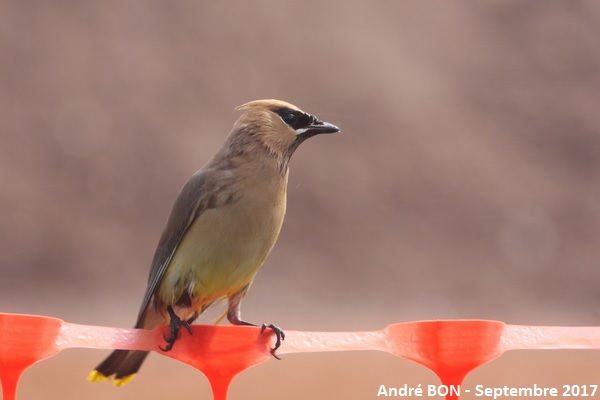

| Cedar Waxwing (Bombycilla cedrorum (Vieillot, 1808)) |


|
|
Scientific name: Bombycilla cedrorum (Vieillot, 1808) Common name: Cedar Waxwing French name: Jaseur d'Amérique, Jaseur des cèdres. Order: Passeriformes Family: Bombycillidae Size: Body size: 15 to 18 cm; Weight: 28 to 32 g; Wingspan: 22 to 30 cm. Habitat: Open forests, woodland edges, orchards, parks and gardens. Food: Cedar Waxwing mainly feed on fruits and sometimes on tree sap and insects. Nesting: The nest is a large cup located on a branch of a tree, often quite far from the trunk. There are one or two clutches of two to five eggs per year. Migration: In winter Cedar Waxwings move south depending on the availability of fruits for their diet. They fly to the southern United States and Mexico and sometimes a little further south. Geographic area: North America, southern Canada and northern half of the United States. |
Cedar Waxwings have a silky-looking, caramel-coloured plumage. The head bears a long brownish crest and a broad black patch over the eyes. The belly is pale yellow. The undertail feathers are white and the tip of the tail is bright yellow. The bill is short and strong. The legs are short. The tips of the secondary feathers are red as if dipped in wax. Juveniles have greyer plumage. There is a possible confusion with the Bohemian Waxwing (Bombycilla garrulus). This last one has a greyer belly without yellow colour. It also has some reddishness under the black mask and on the undertail feathers. |
| [To know more about the Cedar Waxwing] [Next picture] [Top] |

|
You don't have to go deep into nature to see beautiful birds. I photographed this Cedar Waxwing on the side of the street in the town of Percé. It was perched on the signal strips of an area under construction. |
| [To know more about the Cedar Waxwing] [Previous picture] [Top] |

|
Next time I will try to find an angle of view so that we can see the small red spot formed by the tip of the secondary feathers. |